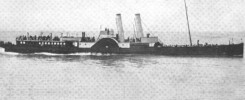
Built in 1900, the Balmoral was the crack long distance excursion paddle steamer of what came to be called Red Funnel emerging from her winter slumbers for only the peak weeks each season and sailing in the Edwardian era in the run up to the First World War and then between the Wars usually taking the long distance coastal and cross channel sailings from Southampton, the Isle of Wight Piers and Bournemouth.
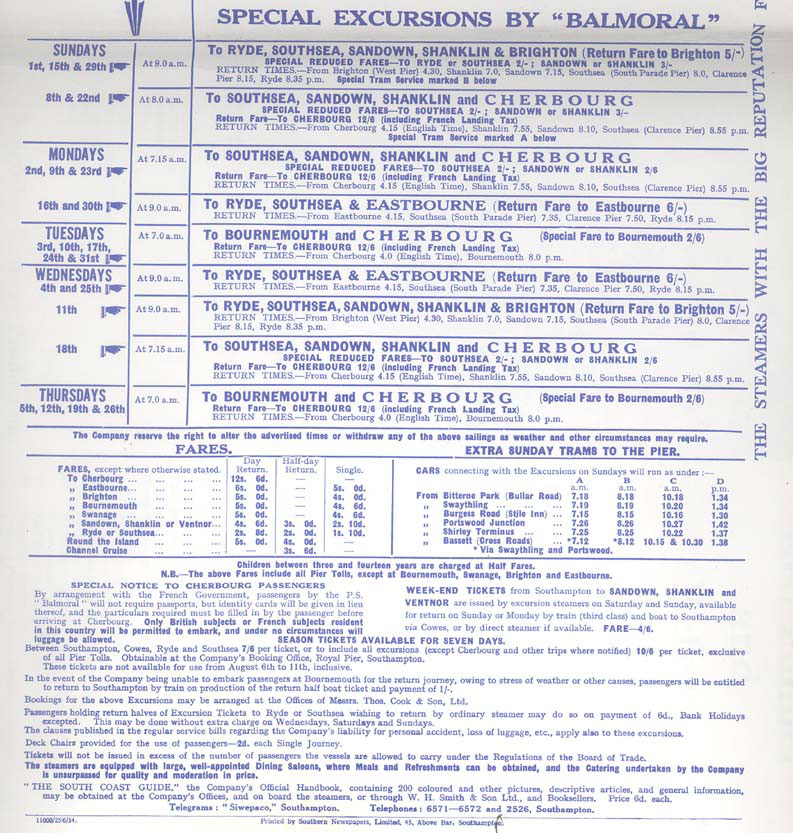
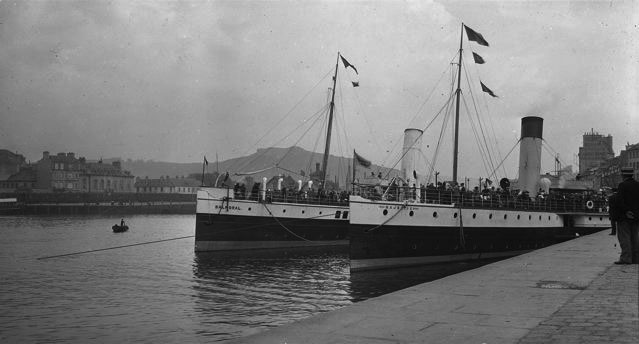
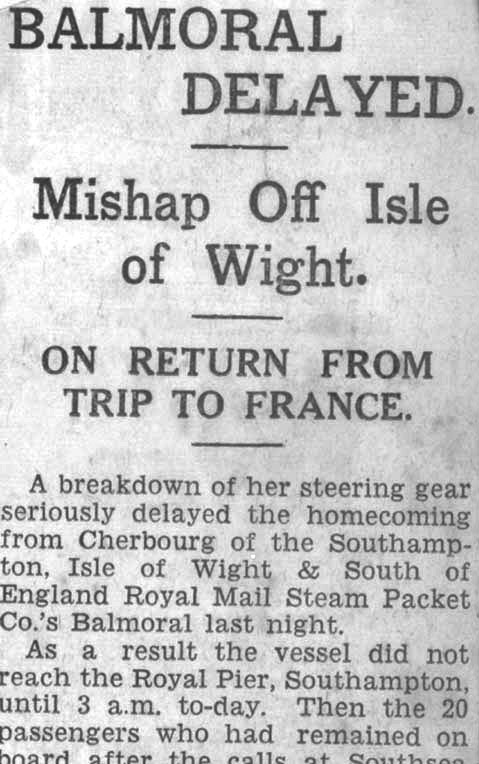
Like most excursion steamers of the time, the Balmoral was a well maintained and generally very reliable vessel but inevitably, from time to time, things did not go entirely according to plan as a cutting from the Southampton Echo from July 1937 demonstrates:
A breakdown of her steering gear seriously delayed the homecoming from Cherbourg of the Isle of Wight & South of England Royal Mail Steam Packet Co’s “Balmoral” last night. As a result the vessel did not reach the Royal Pier, Southampton until 3am today. The 20 passengers who had remained on board after the Calls at Southsea and Ryde, quickly proceeded to their homes.
Not many hours previously the Southern Railway Co’s paddle steamer “Southsea” had got into difficulties within a mile or two of the position in which the Southampton steamer was incapacitated.
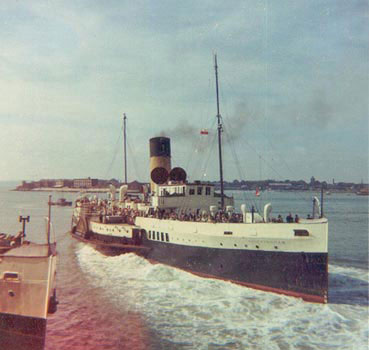
The “Balmoral” had about 400 holiday-makers on board when the breakdown occurred as she was about to come alongside Shanklin Pier after a rough Channel crossing. When she appeared to have almost completed the berthing she went astern and pulled clear of the pier and stood off at a distance. The vessel remained thus for upwards of three hours and midnight had passed before temporary repairs were effected and the vessel was able to proceed.
By that time there were problems in the way of landing passengers at Shanklin and Sandown, so that the “Balmoral” went direct to Southsea where the majority of passengers were landed, and afterwards to Ryde. At the latter resort, three passengers who were to have joined the “Balmoral” at Shanklin came aboard, the Isle of Wight Steam Packet having borne the expense of their car journey across the island by car. This trio consisted of an elderly man, a young woman and a small lad, the last named of whom thoroughly enjoyed the thrill.
We had no idea that anything was wrong until the “Balmoral” pulled away from Shanklin Pier astern after first approaching it” said the passengers to the “Echo”. “Then the vessel stopped and when the passengers were tired of waiting for her to get underway again the majority of them settled down to sleep off the effects of the boisterous crossing.
Everyone accepted the position philosophically and when Ryde was reached the passengers joined in giving three rousing cheers for the “Balmoral’s” captain.” Holiday makers who left the ship at Ryde but would normally have disembarked at Shanklin and Sandown were transported across the island on motor coaches and motor cars at the expense of the Isle of Wight Co who made every effort to ease the difficulties of people in their efforts to return home.
At Bournemouth this morning the Echo was informed that the “Balmoral” would not be making its usual trip to Cherbourg today but that the vessel would be ready for the trip next Thursday.
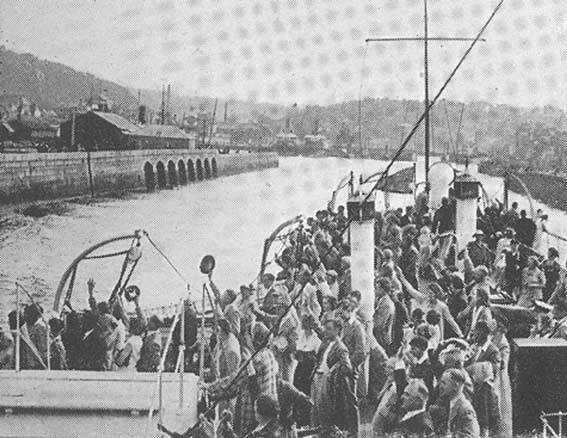
The cross channel flyers like the Balmoral must have been subject to the most stresses and strains and wear and tear of all the excursion paddle steamers with their schedules taking them out onto the high seas into potentially quite heavy weather. Of course sailings were cancelled when it was too rough and on many days it would have been fairly flat. But there would have been some days when it was marginal with the seas a bit too much for them flexing their hulls and thereby their machinery and clogging up their paddle boxes setting up hydraulic pressures of some force on their lightly built constructions. Note the press cutting above speaks of a “rough Channel” and “boisterous crossing”. And although they were large paddlers by the standards of local and coastal excursion steamers, they weren’t large in comparison with most sea-going ships or cross channel ferries.
This day was not an isolated example either. R B Adams, in his excellent book “Red Funnel and Before”, records that in September 1905 the Balmoral was hit by a heavy sea off Dunnose which put her steering gear out of action and another fateful occasion in September 1929 when her paddle shaft snapped in Poole Bay.
On the whole press reports show that passengers seem to have been pretty understanding of these sorts of difficulties and delays, took it all in good part and did not create much fuss. As the Southampton Echo reports: “Everyone accepted the position philosophically” and “passengers joined in giving three rousing cheers for the Balmoral’s captain” who was likely to have been Capt Goldsmith, her master for most of her career.
Perhaps people were made of sterner stuff then. Perhaps they just had a greater understanding of the difficulties. Perhaps they just liked a little adventure with a safe outcome every now and again to recount to the neighbours over the garden fence when they got home: the tale of the long, dark night when Mum, Dad, sister Doris and Auntie Sadie got stranded on the Balmoral off Shanklin.
Picture of the Balmoral and Majestic at Cherbourg from the collection of Alain Kaller.
Guy Hundy has emailed to remind us that J E Cowper recalled his boyhood experience of a stormy cross Channel trip on the PS Balmoral in the Spring 1973 edition of Paddle Wheels:
It was the last trip of the season to Shanklin and Cherbourg in, I should think, 1903, 4 or 5. Although the day broke sunny, the barometer was falling sharply. There were on board about 300 from the Midlands. Soon after leaving Shanklin, sunshine gave way to heavy rain and by mid-channel a fierce south westerly gale had blown up. However we were only a little late at Cherbourg and had about one and a half hours ashore. When we were due to leave, the skipper thought it would be wiser to remain tied up. However, the party from the Midlands told the Captain that it was imperative that they get back for work on Monday morning. So we set sail in the SW gale. Balmoral behaved splendidly in mountainous seas. Most people were sick and the waves smashed some saloon windows besides removing a ventilator or two. Due at Shanklin at 8pm, we did not make it until 11pm and then broke five ropes before landing. The vessel had to call at Southsea before going on to Southampton, so I should think the seasick Midlanders would have been unfit for work on Monday!
It makes interesting reading although if a captain sailed in those conditions and suffered that much damage in the modern litigious world that we all live in now then he would in all likelihood have been prosecuted for his mistakes. It is salutary to remember that an Isle of Wight hovercraft captain was jailed last summer; an Italian master mariner is currently on trial with the prosecution urging a fifteen year sentence; and a South Korean ferry master was jailed for thirty six years last November. And that’s just last year. Of course they all made dreadful mistakes which had terrible consequences but the one thing they all have in common is that none of them went to work on each of their fateful mornings with the intention of doing harm. In the light of this, is it any wonder that masters today are becoming ever more cautious and risk averse?
Kingswear Castle returned to service in 2023 after the first part of a major rebuild which is designed to set her up for the next 25 years running on the River Dart. The Paddle Steamer Kingswear Castle Trust is now fund raising for the second phase of the rebuild. You can read more about the rebuilds and how you can help if you can here.
John Megoran

